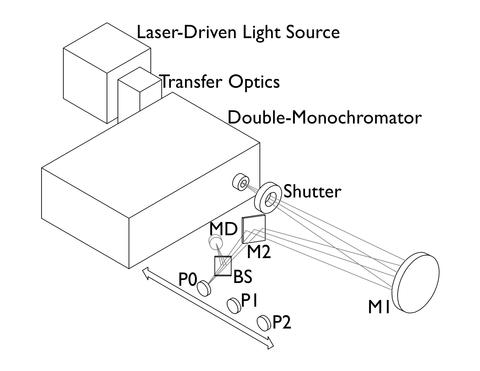Argon mini-arc meets its match: Use of a laser-driven plasma source in ultraviolet-detector calibrations
Summary
The National Institute of Standards and Technology operates two spectral comparator facilities, both of which are used to provide detector calibrations from the ultraviolet to the near-infrared spectral range. One, the Ultraviolet Spectral Comparator Facility (UV SCF), has been in operation for more than two decades, providing one of the core calibration services. Recently, the illumination source used in the UV SCF has been changed from an argon mini-arc source to a laser-driven plasma light source. This new source has higher brightness, a smaller source size, better temporal stability, and much better conversion efficiency than the previous source. The improvements in the capabilities are summarized.
Description

Many national measurement institutes, like the National Institute of Standards and Technology (NIST), provide radiometric detector and source calibration services, which span the optical portion of the electromagnetic spectrum. Optical radiation includes the ultraviolet, visible, and infrared spectral regions. NIST operates two spectral comparator facilities, an ultraviolet system, called Ultraviolet Spectral Comparator Facility (UV SCF), which covers the wavelength range from 200 nm to 500 nm, and a visible and near-infrared setup, called Vis/NIR SCF, which covers the wavelength range from 350 nm to 1800 nm. In both systems, the spectral radiant power responsivity of photodetectors is determined. The absolute spectral power responsivity scale is established using absolute cryogenic radiometers (ACR) and transfer standards, usually trap detectors or photodiodes. A cryogenic radiometer uses electrical substitution at liquid-helium temperatures to determine absolute radiant power, i.e., the ACR ties the optical power to the electrical power. Currently, trap detectors and photodiodes are calibrated as transfer standards using tunable lasers and an ACR at the spectral irradiance and radiance responsivity calibrations using uniform sources (SIRCUS) facility. Then working standard detectors are calibrated using the UV SCF and two transfer standard detectors. To accomplish this, a working standard detector is mounted in position P0 (see figure on the upper right), and two transfer standard detectors are mounted in positions P1 and P2. In the same way the customer's devices are calibrated using these working standards, working standards are calibrated using transfer standards.
Replacement of the AMAS in the UV SCF by a LDLS significantly increased the available optical power in the detector plane. The boosted optical power will make it possible to shorten the calibration chain, and, in the future, working standard detectors will be calibrated directly against an ACR in the UV SCF, thus eliminating all uncertainties resulting from the use of transfer standards, which were calibrated in a separate system with a different light source and optics. Any uncertainty caused by differences in bandpass, out-off-band radiation, spectral purity, collimation, or data extrapolation will be removed. This will reduce the uncertainties of the calibrations done using the UV SCF, especially in the short-wavelength range below 220 nm. The LDLS is temporally stabler than the argon mini-arc, which reduces the uncertainties in the data acquisition through improved data-acquisition statistics. Other benefits of using the LDLS are low power consumption and therefore no increase in ambient temperature, which used to be an issue with the argon mini-arc. In addition, the LDLS is safer to operate than the AMAS because it does not require a high-voltage strike to start the plasma discharge. The LDLS emits a broadband continuum from the ultraviolet to the near-infrared, making it also useful in the Vis/NIR SCF. First tests were promising and showed significant increase in optical power over the whole spectral range. Using the LDLS in the Vis/NIR SCF will also expand its use to shorter wavelengths, at least down to 300 nm.

